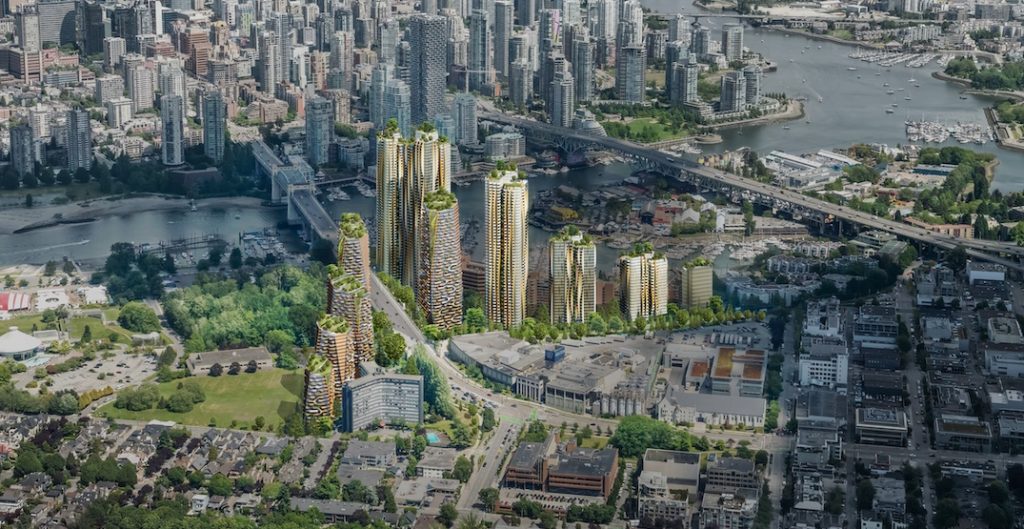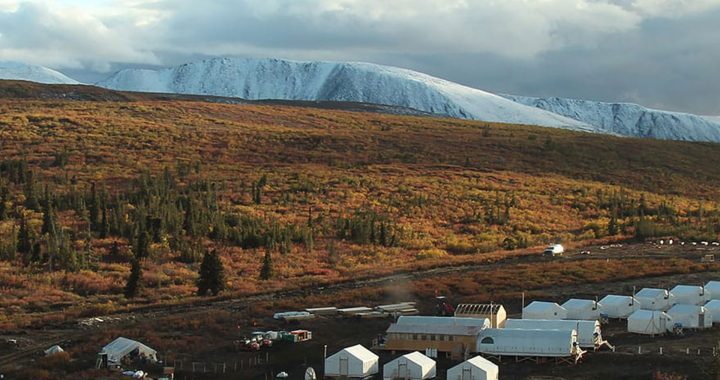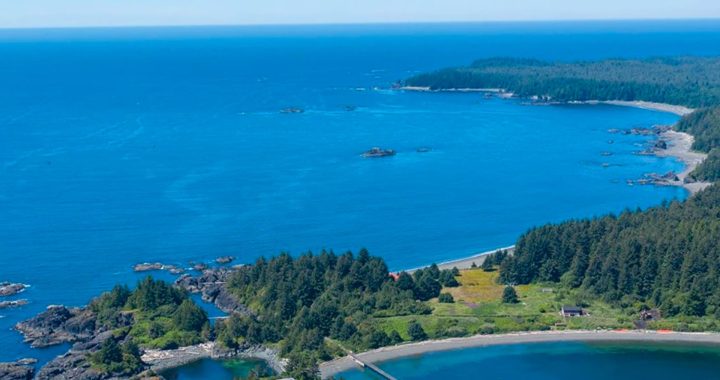
2021 artistic rendering of Senakw (Westbank/Squamish Nation Supplied)
Using a hand-carved tool that was traditionally used for digging post holes for houses, Squamish Nation chairperson Khelsilem breaks ground on a 4.5 hectare development site flanking the Burrard Bridge in Vancouver.
The new development is called Sen̓áḵw.
This was a happy occasion for the Squamish Nation, but residents of nearby Kits Point are raising concerns about land use and a lack of consultation.
A particular rallying point for the community is regarding a piece of land in Vanier park that is to be developed as an access road.
The new Squamish Nation-owned community will have more than 6,000+ units—mostly rental homes across 11 towers according to the proposal. The development has multi-family units and could support about 9000 residents.
“We have been internally doing a lot of work—our admin team, the Squamish nation and leadership. We have been working diligently for the past four years to get to the point that we can start engaging with our community,” says Sxwíxwtn, also called Wilson Williams, a spokesperson and Squamish Nation counsellor.
“We got 87 per cent approval internally for the development and have been walking forward with our community in regards to the next steps,” he says.
Sxwíxwtn notes that the next steps in consultation will be about helping to provide education to the residents of Vancouver about the Squamish Nation’s ancestral connection to the land.
Robert Jago, a local writer who is working in government relations for Kwantlen First Nation, has been outspoken online in the support of the Squamish Nation development.
“They had their land stolen in like the ‘30s to build this neighborhood which is like the stereotype of Vancouver distilled into eight blocks,” says Jago.
The land was an ancestral village for the Squamish people known as Sen̓áḵw.
In 1877 the federal government created Kitsilano Indian Reserve No. 6. In 1913 the community of Squamish people were evicted by the growing city of Vancouver.
“They loaded them on to a barge, and there’s photos of this, and they sent them away to the suburbs and then they burned down their barns and houses and stuff to make room for these white people,” said Jago.
The land was developed as a military base and then eventually converted to residential living space.
Since reclaiming their land through a legal battle in the ‘70s, the Squamish have designed a community that will have rental homes alongside housing for Squamish Nation members.
At the Sept. 6 day ground-breaking ceremony, Prime Minister Justin Trudeau released a statement that read in part: “Today’s announcement not only builds more much-needed homes for Vancouverites, it supports the Squamish Nation’s vision for their traditional lands and their path to continued economic independence and self-determination.”
Vanier Park to have a new access road
Senakw will be a substantial addition to Vancouver’s rental housing & help secure the economic future of the Squamish. But should part of a public park be sacrificed to accommodate an access road to the site (when other options are available)? For details: https://t.co/eZ7GAP3B3d pic.twitter.com/gxSbmcUGZb
— No Senakw Road Through Vanier Park (@NoSenakwRoad) October 1, 2021
At issue for Kits Point residents is a section of land in Vanier Park where the road has been proposed and is owned by the Government of Canada. The land is leased to the city and operated by the Park Board. This access road would run along side the site and encroach on a part of the edge of Vanier Park.
“The development is accessible through a tiny trail next to the bridge and the seawall but there’s no road access. So in order to be able to get road access they need to take this little lane that goes beside the park and expand it into a proper road,” says Jago.
“The way I have been hearing it, they were hoping we would put the road on our land but the placement makes perfect sense between the park and the new development and it is an upgrade. It will become an evacuation route, and it will become safer with lighting and a bike lane,” says Sxwíxwtn.
The federal government has granted a license to the Squamish Nation for a road, including pedestrian and bike access, on this section of federal land.
“It is just a place you go through that has thick dense blackberries, dried-up rocks and nothingness,” said Jago.
The City of Vancouver provided a statement that says that neither it nor the park board have jurisdiction for any decisions regarding the license. Because the development is entirely on First Nations land, the Squamish Nation is not required to consult with the community or adhere to City of Vancouver land use designations.
They do have a lease agreement that shows that the land agreement is for use as a public park, recreational and museum purposes.
Protests Planned
The website, No Vanier Park Road does not provide and names or contact information about who is organizing the protests against the road, but Kits Point resident Jeremy Braude confirmed to APTN news that he built and maintains the website and is organizing the protests against the roadway that are scheduled for September 17. Braude says that to-date 359 people have signed the petition against the road.
Braude, in an email response to APTN, says the concern is about an unnecessary loss of public parkland.
If you care about a swath of virgin Vanier Park forest being sacrificed, so that the co-developers of Senakw (the Squamish Nation and Westbank) can have an unnecessary access road to their site, please join this Rally. Once the forest is gone, it’s forever. pic.twitter.com/8XyAwhrw6r
— Jeremy Braude (@jeremyb1949) September 8, 2022
“On a personal basis, I believe the development is beneficial from the perspective of supplying a good amount of rental accommodation, in a good location, for the citizens of Vancouver,” he says.
“I can’t understand why the Federal government and the Vancouver Parks Board is not concerned by the loss of 1.4 acres of grassed park space and forest.”
The website and messages from Braude focus on the road itself, but on his website, he raises a concern about increased population density in the area and notes that the access road is an essential part of that development, noting that Senakw “appears only attainable if a service road through Vanier Park is provided”.
“Ultimately they just don’t want the 9,000 people living there because in all of Kits Point there might be 7,000 people there. And the people moving in are renters, of all things,” says Jago.










